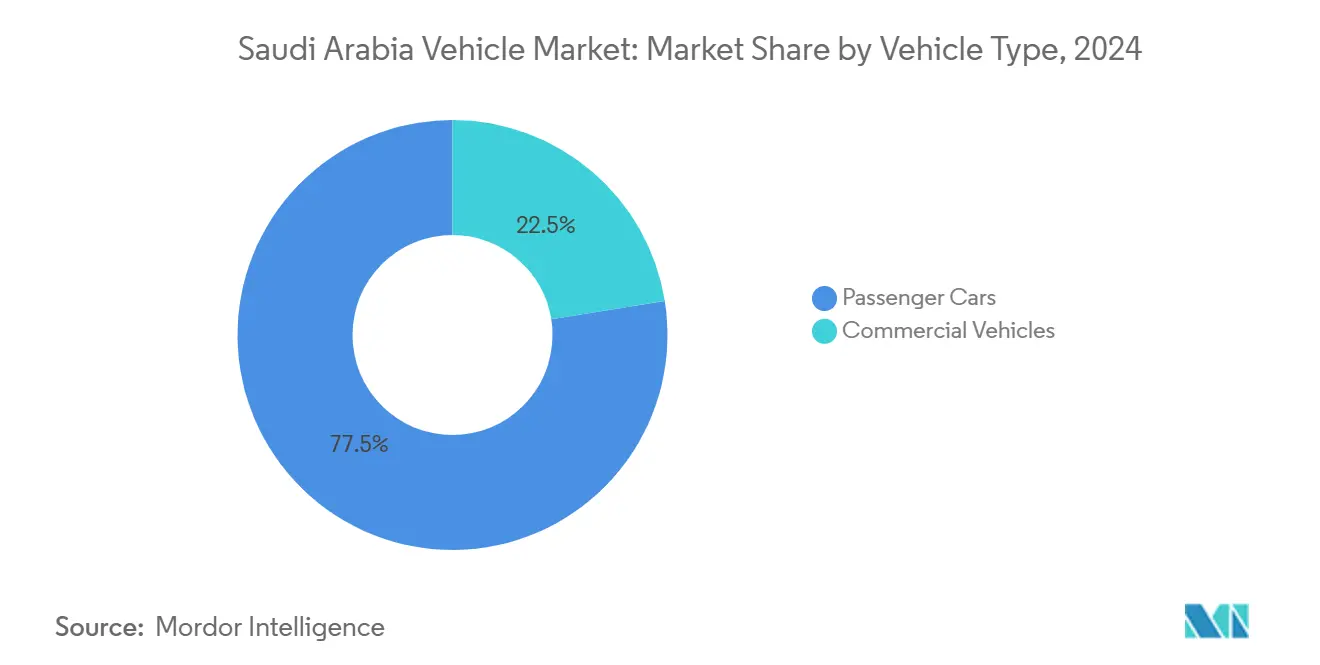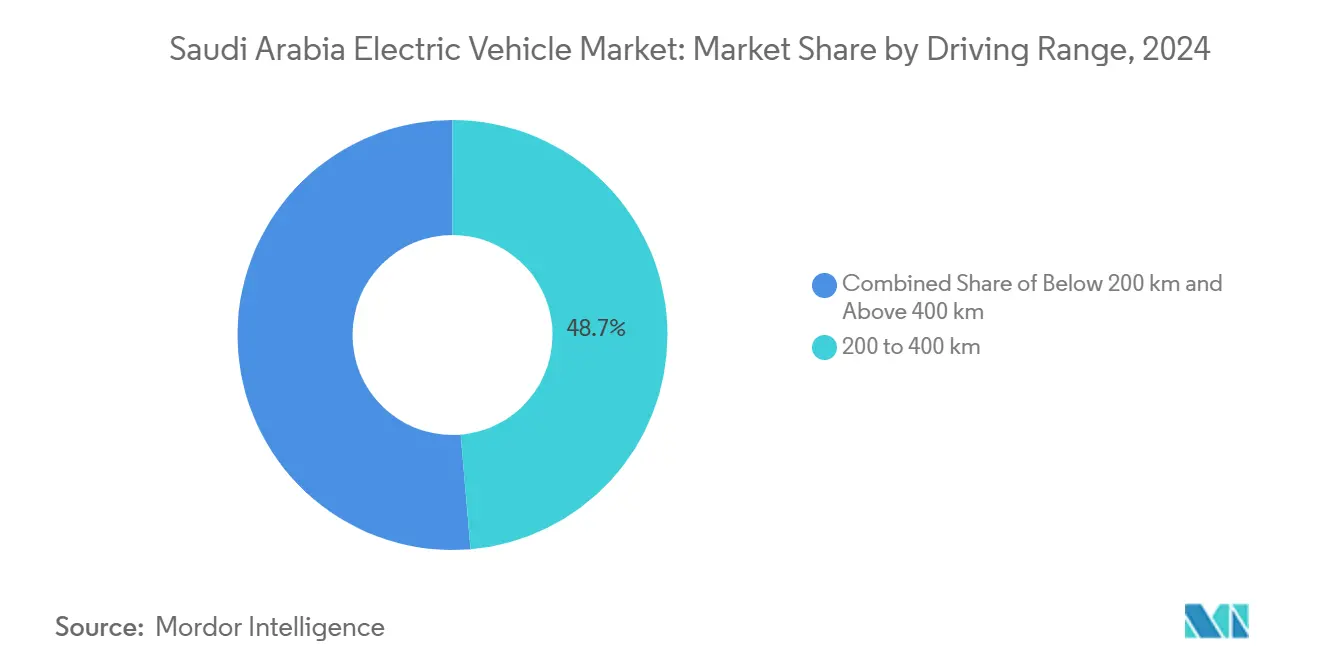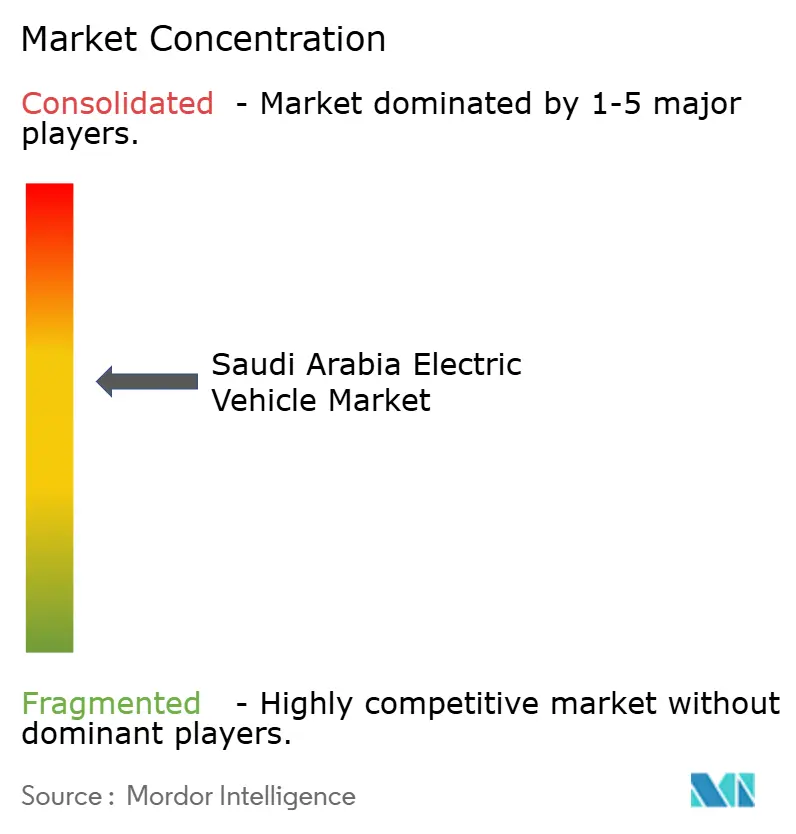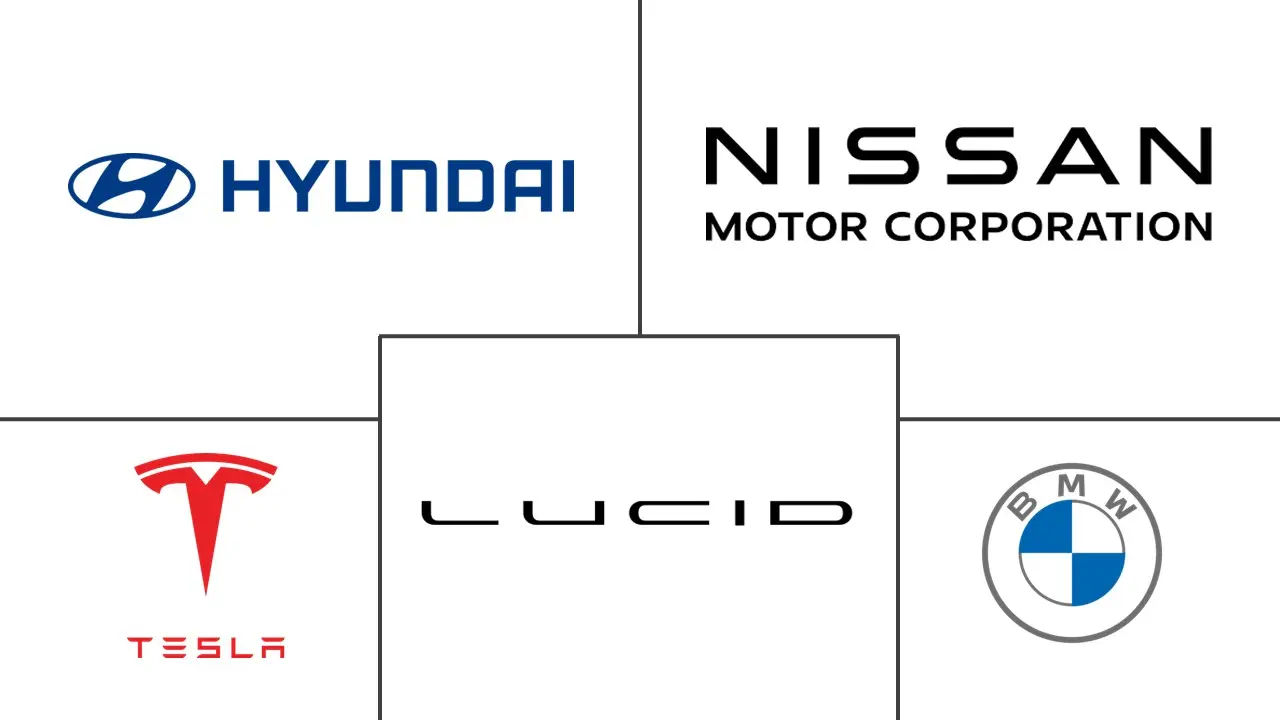Saudi Arabia Electric Vehicle Market Size and Share

Saudi Arabia Electric Vehicle Market Analysis by Mordor Intelligence
The Saudi Arabia electric vehicle market is valued at USD 0.62 million in 2025 and is forecast to reach USD 1.86 million by 2030, advancing at a 24.55% CAGR. The surge is tied to Vision 2030’s diversification goals, sizable Public Investment Fund allocations, and Riyadh’s objective to make 30% of its fleet electric by 2030[1]“رؤية السعودية 2030,” Vision 2030,Vision 2030, vision2030.gov.sa. Large-scale domestic production commitments from Lucid and Ceer signal growing supply-side depth, while persistent battery cost declines and rapid charger rollouts are improving total cost of ownership. Policy emphasis on green hydrogen opens a second technological pathway, positioning the Saudi Arabia electric vehicle market as a regional catalyst for fuel-cell adoption. Intensifying OEM partnerships, expanding public–private charging infrastructure, and mandatory fleet-electrification quotas reinforce demand visibility across consumer and commercial segments.
Key Report Takeaways
- By vehicle type, passenger cars led with 77.53% revenue share in 2024; commercial vehicles are projected to grow at a 34.68% CAGR through 2030.
- By fuel type, battery electric vehicles commanded 53.02% of the Saudi Arabian electric vehicle market share in 2024, while Fuel Cell Electric Vehicles are poised for a 37.82% CAGR to 2030.
- By driving range, the 200–400 km category captured 48.67% share in 2024; above-400 km vehicles are forecast to expand at a 31.65% CAGR.
- By power output, 100–200 kW models held 51.24% share of the Saudi Arabian electric vehicle market size in 2024; above-200 kW vehicles are set to rise at a 36.74% CAGR.
- By geography, Riyadh Province dominated with a 35.89% share in 2024, whereas Eastern Province is expected to register the fastest 29.41% CAGR.
Saudi Arabia Electric Vehicle Market Trends and Insights
Drivers Impact Analysis
| Driver | (~) % Impact on CAGR Forecast | Geographic Relevance | Impact Timeline |
|---|---|---|---|
| Vision-2030 EV Incentives and Manufacturing Funds | +8.6% | Riyadh Province, Eastern Province, Makkah Province | Long term (≥ 4 years) |
| Rapid Public-Private Charging Build-Out | +6.1% | Riyadh Province, Makkah Province, Eastern Province | Medium term (2-4 years) |
| Battery‐Pack Cost Decline & Local Cell Projects | +4.9% | Eastern Province, Riyadh Province | Medium term (2-4 years) |
| Mandatory Fleet-Electrification Quotas | +3.7% | Riyadh Province, Makkah Province | Short term (≤ 2 years) |
| PIF-Backed Domestic OEM Launches | +2.9% | Eastern Province, Riyadh Province | Long term (≥ 4 years) |
| Cross-GCC Green-Mobility Corridors | +2.0% | Eastern Province, Rest of Saudi Arabia | Long term (≥ 4 years) |
| Source: Mordor Intelligence | |||
Vision 2030 EV Incentives & Manufacturing Funds
Vision 2030 earmarks a USD 39 billion funding envelope for the electric-mobility ecosystem, of which USD 18 billion is channeled into new manufacturing lines[2]“National Investment Strategy,” Ministry of Investment of Saudi Arabia, misa.gov.sa. Lucid alone secured USD 3.4 billion in production incentives for its King Abdullah Economic City plant, enabling a 155,000-unit annual capacity. The National Investment Strategy simplifies foreign investment approvals while mandating local-content thresholds, prompting ventures such as the USD 500 million Hyundai–PIF plant that embeds technology transfer clauses. These measures offer scale advantages, lower landed costs, and accelerate localization, anchoring long-run growth of the Saudi Arabia electric vehicle market.
Rapid Public-Private Charging Build-Out
The Electric Vehicle Infrastructure Company targets over 5,000 fast chargers by 2030, easing range anxiety for electric vehicle owners. Tier-one corridors are nearly saturated, and secondary-city expansion is accelerating, boosting utilisation rates and improving the economic case for operators. This infrastructure visibility underpins adoption across both consumer and fleet segments, reinforcing positive network effects for the Saudi Arabia electric vehicle market.
Battery-Pack Cost Decline & Local Cell Projects
The USD 899 million EV Metals Arabia complex in Jubail will supply 150,000 tpa of lithium hydroxide annually from 2026. Proximity to petrochemical feedstocks and ports reduces logistics costs, while Hithium’s 5 GWh facility diversifies the domestic cathode-active-material base. Aramco and Ma’aden’s minerals joint venture secures upstream resources, and sulfur-rich lithium-sulfur pilot lines promise 30–40% battery cost reductions. Local content in batteries not only improves supply security but also enhances Saudi Arabia's electric vehicle industry export potential.
Mandatory Fleet-Electrification Quotas (Ride-Hailing, Government)
The Royal Commission for Riyadh City added 223 electric buses in Stage 2 of its programme, bringing the fleet to 560 units[3]“Royal Commission for Riyadh City Announces the Start of Stage 2 of Riyadh Bus Service,” Saudi Press Agency, spa.gov.sa. SADAFCO and other corporates now embed zero-emission targets in distribution contracts, shortening payback periods through higher utilisation. Regulatory updates for taxis require environmental compliance, prompting ride-hailing platforms to procure compliant fleets. Depot-based charging lowers per-vehicle infrastructure spending, creating a scalable template adaptable to commercial logistics nationwide, further accelerating the Saudi Arabia electric vehicle market.
Restraints Impact Analysis
| Restraint | (~) % Impact on CAGR Forecast | Geographic Relevance | Impact Timeline |
|---|---|---|---|
| Sparse Fast-Charging Outside Tier-1 Cities | -4.4% | Rest of Saudi Arabia, Eastern Province | Medium term (2-4 years) |
| Extreme Ambient Temperatures Degrading Battery Life | -2.9% | Eastern Province, Riyadh Province, Rest of Saudi Arabia | Long term (≥ 4 years) |
| Persistently Subsidised Gasoline Dampening TCO Advantage | -2.0% | Riyadh Province, Makkah Province, Eastern Province | Medium term (2-4 years) |
| Shortage Of EV-Trained Service & Repair Workforce | -1.5% | Rest of Saudi Arabia, Eastern Province | Short term (≤ 2 years) |
| Source: Mordor Intelligence | |||
Sparse Fast-Charging Outside Tier-1 Cities
More than half of the charging points are concentrated in Riyadh, Jeddah, and Dammam. The Kingdom’s scale requires high-power corridor chargers and grid upgrades, yet low traffic volumes challenge operator economics. Government subsidies and corridor mandates are under preparation, but timelines extend beyond market needs, tempering growth prospects in non-metro areas of the Saudi Arabia electric vehicle market.
Extreme Ambient Temperatures Degrading Battery Life
Summer temperatures above 50 °C reduce real-world range by up to 25% and accelerate battery aging[4]“Integration of Electric Vehicles in Areas of Extreme Heat,” International Energy Agency, iea.org. OEMs are engineering advanced thermal-management systems and dust-proof enclosures, yet these solutions raise upfront vehicle prices. Charging-station hardware also demands frequent maintenance. Adapting technology to desert conditions remains essential for sustained gains in the Saudi Arabia electric vehicle industry.
Segment Analysis
By Vehicle Type: Commercial Segments Drive Electrification
Passenger cars captured 77.53% of the Saudi Arabian electric vehicle market in 2024, buoyed by purchase incentives and growing consumer familiarity. Growth moderates as early adopters saturate, yet premium sub-segments continue to expand alongside Tesla’s imminent entry. Commercial vehicles are forecast to grow at a 34.68% CAGR, propelled by fleet mandates, cost-of-ownership advantages, and depot-charging economics that improve utilisation. Light-duty logistics fleets gain from predictable routes, while medium trucks and buses benefit from public procurement and urban clean-air objectives.
The commercial uptrend compresses payback periods to 3–4 years, compared with 6–8 years for individual buyers. Premium SUVs and sports cars serve affluent consumers seeking performance and status, adding volume in the 100–200 kW band. Collectively, these dynamics widen the customer base and diversify revenue streams for the Saudi Arabian electric vehicle market.

By Fuel Type: BEV Dominance with FCEV Emergence
Battery Electric Vehicles held 53.02% of the Saudi Arabian electric vehicle market share in 2024, leveraging the most mature charging network and fiscal incentives. Plug-in hybrids remain a transitional choice in regions with charger gaps, while conventional hybrids serve price-sensitive buyers. Fuel Cell Electric Vehicles will grow at a 37.82% CAGR, catalysed by NEOM’s 600-ton-per-day green-hydrogen plant and Hyundai–Red Sea Global fleet pilots. Aramco’s inaugural hydrogen station demonstrates supply-chain feasibility and aligns with national hydrogen-export ambitions.
BEV adoption is challenged by rural charging scarcity, whereas FCEV growth hinges on costly compression and distribution infrastructure. Coordinated investments in hydrogen corridors could unlock a second growth leg for the Saudi Arabian electric vehicle industry, diversifying technology risk.
By Driving Range: Long-Range Preference Emerges
The 200-400km driving range segment dominates with 48.67% market share in 2024, reflecting consumer preferences for vehicles capable of inter-city travel while remaining within charging infrastructure coverage areas. Below-200km range vehicles serve primarily urban applications and fleet use cases where predictable daily mileage patterns enable reliable charging scheduling. Above-400km range vehicles represent the fastest-growing category at 31.65% CAGR, indicating consumer preference for longer-range capabilities that reduce charging frequency and range anxiety.
Consumer preference shifts toward longer-range vehicles reflect the Kingdom's geographic characteristics, with significant distances between major cities requiring extended range capabilities for practical EV adoption. The segment benefits from advancing battery technology and decreasing costs per kWh, making longer-range vehicles increasingly accessible to mainstream consumers. Fleet operators particularly favor longer-range vehicles for commercial applications, where reduced charging stops improve operational efficiency and driver productivity. The above-400km segment's growth trajectory aligns with international EV trends and technological improvements in battery energy density.

Note: Segment shares of all individual segments available upon report purchase
By Power Output: High-Performance Growth Accelerates
The 100- 200 kW power output segment leads with 51.24% market share in 2024, representing the optimal balance between performance and cost for mainstream consumer applications. Below-100 kW vehicles serve entry-level and urban-focused applications, while above-200 kW vehicles achieve the highest growth rate at 36.74% CAGR, reflecting consumer preferences for high-performance EVs and luxury segment expansion.
High-power output vehicles benefit from affluent consumer segments' early adoption patterns and premium brands' focus on performance differentiation in the EV market. The above-200kW segment includes luxury sedans, high-performance SUVs, and sports cars that appeal to Saudi Arabia's affluent consumer base and align with the Kingdom's positioning as a luxury destination. Fast-charging compatibility becomes increasingly important for high-power vehicles, with ultra-fast charging infrastructure development supporting this segment's growth through reduced charging times and improved user experience.
Geography Analysis
Riyadh Province contributed 35.89% of 2024 sales, driven by large municipal fleets, the highest charger density, and policy pilots to demonstrate Vision 2030 targets. Public-transport electrification, including 560 electric buses, cements the city as an early-adopter hub. Expanding metropolitan boundaries and high population density sustain volume growth, while administrative vehicle procurement maintains public-sector demand.
Eastern Province is forecast to grow at 29.41% CAGR through 2030 as industrial infrastructure in Jubail and King Abdullah Economic City nurtures a complete battery-to-vehicle supply chain. Port facilities open export routes to wider GCC and African markets, positioning the region as a manufacturing and logistics anchor for the Saudi Arabia electric vehicle market.
Makkah Province, encompassing Jeddah and the holy cities, represents a sizeable opportunity tied to religious-tourism mobility. Pilgrim shuttles and airport transfers add cyclical peak-demand layers, encouraging operators to trial electric buses and vans for cleaner urban air. Secondary regions benefit from nationwide charging-corridor programmes, gradually reducing the rural adoption gap and expanding geographic breadth of the Saudi Arabia electric vehicle industry.
Competitive Landscape
The market is moderately fragmented. Nissan leveraged an early dealer network to secure a significant share in 2024. Tesla’s forthcoming launch and BMW’s expanding premium lineups add competitiveness. Lucid holds a notable share and gains a structural advantage from its local plant and PIF support, driving down logistics costs and import duties.
Government incentives are increasingly linked to local content metrics, encouraging joint ventures such as Hyundai’s USD 500 million plant with PIF. Ceer Motors, a domestic brand, applies licensed BMW technology and USD 1.5 billion funding to localise platforms and software, promising disruptive potential. Overall, scale, localisation, and integrated supply chains define long-term competitiveness within the Saudi Arabia electric vehicle market.
Saudi Arabia Electric Vehicle Industry Leaders
-
Nissan Motor Corporation
-
Tesla Inc.
-
BMW AG
-
Lucid Group
-
Hyundai Motor Company
- *Disclaimer: Major Players sorted in no particular order

Recent Industry Developments
- May 2025: Hyundai, in collaboration with PIF, has commenced construction on a USD 500 million plant. The plant aims to assemble 50,000 vehicles each year, and production is slated to kick off in 2026.
- April 2025: Saudi Aramco Technologies Company (SATC), a subsidiary of Aramco, has signed a Joint Development Agreement with BYD to develop technologies aimed at improving efficiency and environmental performance in new energy vehicles.
- February 2025: Ceer Motors secured USD 1.5 billion in local partnerships to finance the production start-up in 2026.
- January 2025: Tesla confirmed entry into Saudi Arabia within months, promising Supercharger deployment to support customers.
Research Methodology Framework and Report Scope
Market Definitions and Key Coverage
According to Mordor Intelligence, the Saudi Arabia electric vehicle (EV) market covers every new road-worthy automobile that is propelled wholly or partly by electricity stored on board; this includes battery electric, plug-in hybrid, hybrid, and fuel-cell models sold or assembled inside the Kingdom. Vehicles with off-road, two-wheeler, or aftermarket conversion kits are outside this frame.
Scope exclusion: rebuilt or retro-fitted internal-combustion cars do not enter our market size.
Segmentation Overview
- By Vehicle Type
- Passenger Cars
- Sedan & Hatchback
- SUV and Crossover
- Luxury and Sports
- Commercial Vehicles
- Light Commercial Vans and Pick-ups
- Medium and Heavy Trucks
- Buses & Coaches
- Passenger Cars
- By Fuel Type
- Battery Electric Vehicle (BEV)
- Plug-in Hybrid Electric Vehicle (PHEV)
- Hybrid Electric Vehicle (HEV)
- Fuel-Cell Electric Vehicle (FCEV)
- By Driving Range
- Below 200 km
- 200 to 400 km
- Above 400 km
- By Power Output
- Below 100 kW
- 100 to 200 kW
- Above 200 kW
- By Regional Province
- Riyadh Province
- Makkah Province (incl. Jeddah)
- Eastern Province
- Rest of Saudi Arabia
Detailed Research Methodology and Data Validation
Primary Research
We interviewed charger installers, franchised dealers, provincial regulators, and fleet managers across Riyadh, Eastern, and Makkah provinces. Discussions clarified shadow-import volumes, fast-charger rollout pace, and average transaction prices, enabling us to refine model assumptions and challenge early desk findings.
Desk Research
Our analysts first mapped the demand pool using public datasets such as Saudi Transport General Authority new-registration files, ZATCA customs import codes, Saudi Central Bank consumer-credit bulletins, and Vision 2030 infrastructure dashboards. Global references, IEA Global EV Outlook, UN Comtrade battery trade tables, and peer-reviewed SAE papers on desert climate battery degradation helped benchmark local ratios. Select paid repositories like D&B Hoovers and Dow Jones Factiva supplied company revenue splits that anchored pricing spreads. These sources illustrate our inputs and are not exhaustive; many additional publications supported data checks.
Market-Sizing & Forecasting
The base year value derives from a top-down reconstruction of provincial new-vehicle registrations, adjusted by verified EV penetration rates, then converted to revenue through surveyed average selling prices. Supplier roll-ups and sample dealer channel checks offer a selective bottom-up view that validates totals. Key variables tracked include charger density per 100 km of highway, average battery pack cost per kWh, Vision 2030 adoption quotas, import duty schedules, and Riyadh household disposable income. A multivariate regression that links these drivers to historical uptake informs the 2025-2030 forecast, while scenario analysis handles policy or price shocks. Gaps where bottom-up evidence is thin are bridged with conservative midpoint estimates reviewed by regional experts.
Data Validation & Update Cycle
Outputs pass variance screens against independent signals such as electricity-demand growth, lithium-ion import tonnage, and OEM financial disclosures. Findings move through two analyst reviews before sign-off. We refresh the model annually and issue interim revisions whenever material events, policy shifts, tax changes, or major plant openings occur.
Why Mordor's Saudi Arabia Electric Vehicle Baseline Commands Reliability
Published estimates often diverge because firms define "market" differently, apply varied pricing ladders, or refresh at contrasting cadences.
Key gap drivers include whether components like chargers or aftermarket parts are bundled, if hybrid vehicles are counted as full EVs, and whether cross-border GCC sales inflate domestic totals. Mordor reports only in-country new vehicle sales at end-buyer prices and updates figures each year, which limits double counting and currency drift.
Benchmark comparison
| Market Size | Anonymized source | Primary gap driver |
|---|---|---|
| USD 0.62 million (2025) | Mordor Intelligence | - |
| USD 2,343.7 million (2024) | Global Consultancy A | Includes chargers, batteries, and commercial two-wheelers within headline value |
| USD 560 million (2024) | Industry Databook B | Uses ex-factory shipment prices and excludes government fleet orders |
| USD 9.25 billion (2023) | Regional Consultancy C | Aggregates wider GCC sales and counts future plant investment outlays as current revenue |
The comparison shows that once inconsistent scopes and pricing bases are stripped away, Mordor's disciplined, annually refreshed approach delivers a transparent starting point that executives can trace to clear variables and replicate with confidence.
Key Questions Answered in the Report
What is the current value of the Saudi Arabia electric vehicle market?
The market stands at USD 0.62 million in 2025 and is forecast to reach USD 1.86 million by 2030.
Which vehicle type leads the Saudi Arabia electric vehicle market?
Passenger cars dominate with 77.53% share in 2024, although under commercial vehicle sub-segment commercial vans and pick-ups show the fastest future growth.
How fast is the Fuel Cell Electric Vehicle segment growing?
FCEVs are projected to expand at a 37.82% CAGR through 2030, supported by large-scale green-hydrogen investments.
Which region in Saudi Arabia is the fastest growing for EV adoption?
Eastern Province is expected to rise at a 29.41% CAGR due to emerging battery-manufacturing ecosystem.
What role does Vision 2030 play in the Saudi Arabia electric vehicle industry?
Vision 2030 provides ecosystem funding, enforces local-content rules, and sets a goal for 30% of Riyadh’s fleet to be electric by 2030.
How many fast chargers are planned nationwide by 2030?
The Electric Vehicle Infrastructure Company plans to deploy more than 5,000 fast chargers, with broader initiatives targeting 50,000 total charging points by 2025.
Page last updated on:



